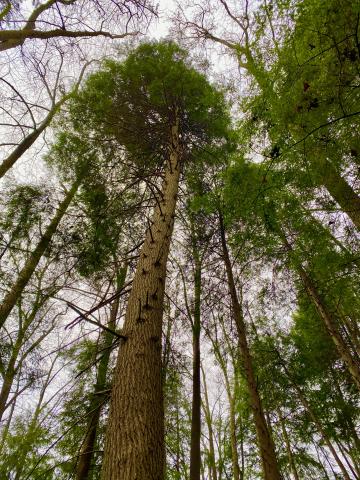Hemlock

Standing in a grove of hemlocks has a feeling of being in a cathedral with high columns. Their close proximity to mountain streams makes for a very picturesque view.
By Steve Roark
Volunteer Cumberland Gap National Historical Park
The hemlock is one of my favorite trees because of its huge size and that it grows along mountain springs and creeks that are usually picturesque and nice places to visit.
The eastern hemlock (Tsuga canadensis) is our local native, and there is also a western species found from the Rockies west. The local name for the tree is spruce-pine. As mentioned, it likes to grow up in the mountains near streams where the soil is cool and moist. It is a majestic tree, reaching a height of 100 feet when mature, and can have a trunk up to 4 feet in diameter. Standing in a grove of large hemlocks makes me feel like I’m in a church cathedral and I can get into a spiritual, awestruck mood.
The tree is easy to identify by its leaves, which are short, flat needles with 2 white stripes on their lower side. The cones are also easy, being less than an inch long, round, and often plentiful on the ground beneath the tree. The bark is a dark brown to reddish color, with narrow grooves flanked by rounded scaly ridges. The branches that make up the canopy come out very perpendicular to the trunk, and are numerous, the lower ones being dead and broken.
Hemlock is a tree of patience and endurance. It only grows in places where other trees have grown and created centuries of leaf mold in deep, organic soil. It can then seed in and survive in the deepest of shade. It grows slowly but steadily up through the shade below other trees until it gets into the forest canopy, where it will inevitably make its way above its neighbors and become the dominant tree. Because young hemlocks can grow under their parents and replace them, a well-established hemlock forest can remain in place for centuries. Tree species that cannot be displaced by other species are referred to as “climax” by forestry folk. Another climax tree found with hemlock is beech, and an evergreen hemlock growing beside the smooth, gray barked beech makes a nice visual contrast.
The wood of hemlock is light in weight and not very strong. It is said to be difficult to work, brittle, and coarse grained. It is used for rough construction work, and I’ve seen it used for house siding, even though it is not rot resistant.
The inner bark contains a tannic acid that was formerly used to tanning leather.
Native Americans and pioneers made a tea from the inner bark to treat colds, fever, diarrhea, and to induce sweating. The bark was also used to make a brown dye. A tea made from the outer twigs and leaves was used to treat kidney ailments.
Seeds of hemlock are eaten by songbirds and squirrels, and the branches are browsed by deer and rabbits.
- Log in to post comments